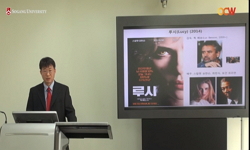As Korean language has affix construction, suffix has been developed well. Suffixes have three functions as follows. First, as with 'Kupt Koo Ru Kee', they does'nt bring any change to the extent of synthetic(통사론) but addition to meaning. Seco...
http://chineseinput.net/에서 pinyin(병음)방식으로 중국어를 변환할 수 있습니다.
변환된 중국어를 복사하여 사용하시면 됩니다.
- 中文 을 입력하시려면 zhongwen을 입력하시고 space를누르시면됩니다.
- 北京 을 입력하시려면 beijing을 입력하시고 space를 누르시면 됩니다.
파생어 형성에 있어서의 의미변화 : 명사류를 중심으로 = Meaning Change of Derivational Word-formation : Through The noun classes
한글로보기https://www.riss.kr/link?id=T3067503
- 저자
-
발행사항
부산 : 東亞大學校 大學院, 1991
- 학위논문사항
-
발행연도
1991
-
작성언어
한국어
- 주제어
-
KDC
715.2 판사항(4)
-
DDC
495.75 판사항(19)
-
발행국(도시)
부산
-
형태사항
48p. ; 26cm
-
일반주기명
참고문헌: p. 44-45
- 소장기관
-
0
상세조회 -
0
다운로드
부가정보
다국어 초록 (Multilingual Abstract)
Suffixes have three functions as follows.
First, as with 'Kupt Koo Ru Kee', they does'nt bring any change to the extent of synthetic(통사론) but addition to meaning.
Second, as with 'Nal+Kae', they change the meaning as well as synthetic.
finally, as with 'muk+hee-' and 'muk+Ee-'(passive to active) they bring changes to synthetic function. (active to passive)
Among thoes suffixes which have first and second functions, this article deals with suffixes which form nouns.
And this study is interested in changing meaning and meaning structure of suffixes which have high tendency to derivatives.
Among Noun-derivative suffixes, suffixes which have wide extent of derivation are <personal suffix>, <things-suffix>, and <activation suffix> in order.
1) Personal suffix
(1) mainly take nouns, verbs and incomplete roots
(2) can be divided into honorific title and humble title mainly humble titles of suffix have been developed.
(3) Suffixes of humble title are {-Koo Ru Kee}, {-Paree}, {-Paeng Ee}, {-Po}, {-Swo Ee} and {-Toong Ee}
(4) Suffix of Physical humble title is {-Taree}.
Suffixes of humble title for speciclists are {-Koon}, {-Jang Ee}, {-Jee Kee} and {-Archee}.
Honorific title for showing more respect is {-neem}
(4) There is limitation of meaning between suffixes which have high tendency to derivatives and roots.
As with {-Koo Rukee}, suffixes are generally integrated with nouns which show personal nature and reveal defects of one's character. And suffixes like {-Koon}, {-Paeng Ee}, {-Po}, {-Archee}, {-Jang Ee} and {-Neem} are integrated and limited in accordance with vocabulary qualityes of roots.
2) things-suffix
(1) mainly integrated with roots of nouns, adjectives and verbs.
(2) suffixes which add the meaning of tool to root are {-ee}, {-kae}, {-kee} and {-Ang Ee} suffixes which mean things themselves (or the names of them) are {-Ja}, {-Kaeng Ee} and {-Jung Ee}
And suffix which mean piece(or chip)is {-Tae kee}
(3) The Suffix {-Kae} has a function of exdocentric construction which is integrat with transitive roots.
Suffix {-Tae Kee} is limited to integrate with the substantial nouns which have a certain space.
3) Behavior Suffix
(1) Is integrated mainly with nouns, adjectives and verbs.
(2) Suffixes which objectify the activity are 〔-(ur)m〕, {-ee} and {-kee} and suffixes which activate the substantiality are 〔-Jeel〕 and 〔-No Reut〕
(3) Suffix {-Jeel} has endocentric and exdocentric function which are decided the extent of meaning in accordance with preceding factors in integration.
{-(ur)m} shows change of conditon and
{-Kee} shows activity or degree and
{-Ee} shows object or unit
As Korean language has affix construction, suffix has been developed well.
Suffixes have three functions as follows.
First, as with 'Kupt Koo Ru Kee', they does'nt bring any change to the extent of synthetic(통사론) but addition to meaning.
Second, as with 'Nal+Kae', they change the meaning as well as synthetic.
finally, as with 'muk+hee-' and 'muk+Ee-'(passive to active) they bring changes to synthetic function. (active to passive)
Among thoes suffixes which have first and second functions, this article deals with suffixes which form nouns.
And this study is interested in changing meaning and meaning structure of suffixes which have high tendency to derivatives.
Among Noun-derivative suffixes, suffixes which have wide extent of derivation are <personal suffix>, <things-suffix>, and <activation suffix> in order.
1) Personal suffix
(1) mainly take nouns, verbs and incomplete roots
(2) can be divided into honorific title and humble title mainly humble titles of suffix have been developed.
(3) Suffixes of humble title are {-Koo Ru Kee}, {-Paree}, {-Paeng Ee}, {-Po}, {-Swo Ee} and {-Toong Ee}
(4) Suffix of Physical humble title is {-Taree}.
Suffixes of humble title for speciclists are {-Koon}, {-Jang Ee}, {-Jee Kee} and {-Archee}.
Honorific title for showing more respect is {-neem}
(4) There is limitation of meaning between suffixes which have high tendency to derivatives and roots.
As with {-Koo Rukee}, suffixes are generally integrated with nouns which show personal nature and reveal defects of one's character. And suffixes like {-Koon}, {-Paeng Ee}, {-Po}, {-Archee}, {-Jang Ee} and {-Neem} are integrated and limited in accordance with vocabulary qualityes of roots.
2) things-suffix
(1) mainly integrated with roots of nouns, adjectives and verbs.
(2) suffixes which add the meaning of tool to root are {-ee}, {-kae}, {-kee} and {-Ang Ee} suffixes which mean things themselves (or the names of them) are {-Ja}, {-Kaeng Ee} and {-Jung Ee}
And suffix which mean piece(or chip)is {-Tae kee}
(3) The Suffix {-Kae} has a function of exdocentric construction which is integrat with transitive roots.
Suffix {-Tae Kee} is limited to integrate with the substantial nouns which have a certain space.
3) Behavior Suffix
(1) Is integrated mainly with nouns, adjectives and verbs.
(2) Suffixes which objectify the activity are 〔-(ur)m〕, {-ee} and {-kee} and suffixes which activate the substantiality are 〔-Jeel〕 and 〔-No Reut〕
(3) Suffix {-Jeel} has endocentric and exdocentric function which are decided the extent of meaning in accordance with preceding factors in integration.
{-(ur)m} shows change of conditon and
{-Kee} shows activity or degree and
{-Ee} shows object or unit
목차 (Table of Contents)
- 목차
- 1. 들어가기 = 1
- 1.1 연구 목적 = 1
- 1.2 연구 범위 및 방법 = 1
- 2. 이름씨 파생법 = 3
- 목차
- 1. 들어가기 = 1
- 1.1 연구 목적 = 1
- 1.2 연구 범위 및 방법 = 1
- 2. 이름씨 파생법 = 3
- 2.1 접미사의 이름씨 전성 = 3
- 2.2 이름씨 파생접미사의 범주 = 6
- 2.3 파생어의 형성 규칙 = 9
- 2.4 이름씨 파생접미사의 의미별 유형 = 11
- 2.4.1 인칭접미사 = 11
- 2.4.2 사물접미사 = 14
- 2.4.3 행위접미사 = 15
- 3. 파생어의 의미변화 및 구조 = 17
- 3.1 인칭접미사 = 17
- 3.1.1 {-꾸러기} = 17
- 3.1.2 {~꾼/-군} = 20
- 3.1.3 {-님} = 22
- 3.1.4 {-뱅이} = 24
- 3.1.5 {-보} = 26
- 3.1.6 {-아치} = 28
- 3.1.7 {-장이} = 30
- 3.2 사물접미사 = 32
- 3.2.1 {-개/-게} = 32
- 3.2.2 {-때기} = 33
- 3.3 행위 접미사 = 34
- 3.3.1 {-질} = 34
- 3.3.2 {-(으)ㅁ, -기, -이} = 37
- 4. 마무리 = 42
- 참고문헌 = 44
- SUMMARY = 46












